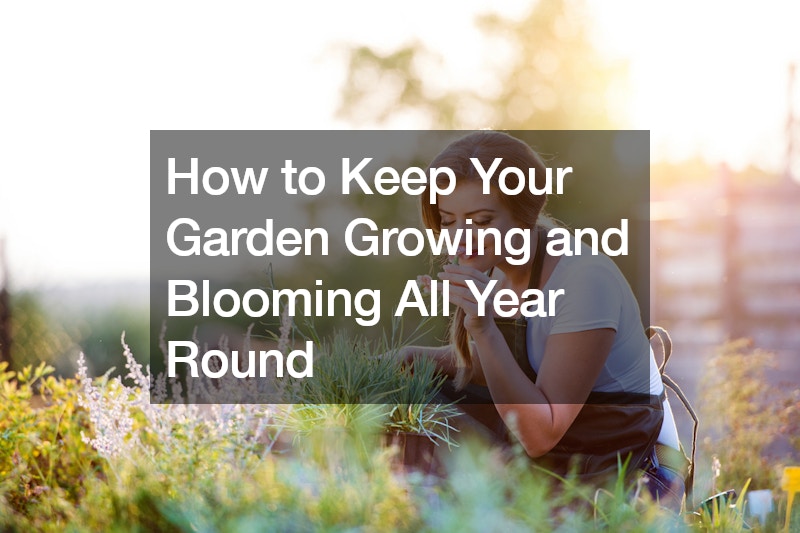Keeping your garden growing and blooming all year round might sound like something from a Disney movie, where the flowers and plants have their magical calendar. It’s doable in the real world, too, and you don’t need a fairy godmother to make it happen. Imagine your garden staying as vibrant and lively as the enchanted one in ‘Beauty and the Beast,’ regardless of the season. Sounds pretty awesome, right? In this article, we’ll show you the ropes of keeping your garden in tip-top shape 365 days a year. Whether you’ve got a green thumb, these tips will make gardening as easy as pie.
Design for Diversity

You know, diversifying your garden can up the game for keeping things growing and blooming all year round. Imagine having a mix of shrubs, perennials, and annuals that take turns showing off. It’s like having a relay team where each plant’s peak blooming period hands off to the next, keeping your garden in a constant performance state.
Then there’s the variety of heights, colors, and textures. You wouldn’t want everything on the same level, would you? Mixing it with tall, medium, and ground-cover plants adds depth and intrigue. It’s like painting a live picture that evolves with the seasons, where each brush stroke adds a unique touch to the masterpiece.
Crafting a diverse garden isn’t just about the visual appeal, though. It also means your garden’s more resilient, bouncing back easier from whatever Mother Nature throws its way. Think about it; if one type of plant struggles, there’s a good shot that another’s thriving, keeping the overall vibe of your garden positive and lively. Who doesn’t love having a year-round excuse to get out there and get your hands dirty?
Choose Suitable Plants

Picking the right plants sounds almost like choosing teammates for a dodgeball game – you have to know who will last through the seasons and who’s not up for it. You don’t just grab any plant that catches your eye; think about how it’ll fare in your garden’s microclimate. Getting the topsoil supply right plays a big part since some plants are picky eaters and need the right nutrients to keep growing and blooming.
Considering the local weather, some plants are real troopers, putting on a show even when the temperature drops or soars. For instance, succulents won’t bat an eyelash in a drought, while ferns love to kick it in the shade and moist soil. It’s like putting together a band where every member rocks their part, rain or shine.
Then there’s the pollinators – we can’t forget inviting those guys over. Planting lavender and bee balm adds a pop of color and rolls out the red carpet for bees, butterflies, and even hummingbirds. It’s like throwing a garden party where the guests help your plants keep the good times rolling by pollinating them, ensuring your garden is vibrant and full of life; no RSVP is needed.
Create Microclimates
Crafting microclimates in your garden feels a bit like being a weather wizard, doesn’t it? You can change the game by using landscape elements strategically. For example, a well-thought-out fence installation can shield some plants from winds while creating a sun trap for others, helping them thrive and bloom way better.
Now, think about spots in your garden always soaking wet or dry as a bone. You’ve gotta work with what you’ve got, right? Placing plants that love moisture in those damp corners and drought-resistant varieties in the dry spots makes your garden survive and thrive. It’s all about matching the plant’s vibe with the right spot, ensuring they grow and bloom without extra fuss.
Here’s a fun trick: Use stones or concrete to your advantage. They soak up heat during the day and release it at night, which is perfect for plants that need a bit more warmth. It’s like throwing a mini slumber party for your plants, where the ground is the heated blanket. Create these cozy nooks, and you’ll see your garden take on a life of its own, with every plant finding its happy place.
Provide Adequate Watering

Watering isn’t just about making it rain whenever your garden looks a bit thirsty; it’s a science that’s as crucial as the sunlight that dances across your blooms. Consider installing irrigation systems to take the guesswork out of the equation. These systems can be set to water your garden at the best times of day, ensuring your plants get the hydration they need without wasting a drop.
You might think, ‘But I like watering my garden; it’s my Zen time.’ That’s cool because there’s something deeply satisfying about holding a hose and giving your plants a drink. But when life gets busy, or you’re out of town, a good irrigation system is like having a reliable buddy who has your back, ensuring your plants keep growing and blooming even when you can’t be there.
And hey, not all plants thirst the same. Some are like those friends who can’t seem to get enough water, while others are more like your low-maintenance buddies, happy with whatever they get. Matching your watering technique to what your garden guests need, maybe through a drip system for the delicate drinkers and a sprinkler for those more robust, can make a difference in how your garden keeps growing and blooming.
Mulch for Moisture Retention
Mulch isn’t just a pretty topping for your garden beds; it’s a moisture-saving superhero. Think of it like a cozy blanket that keeps the soil cool and moist, even when the sun’s trying to dry things out. Whether using wood chips, straw, or cocoa hulls, they all slow evaporation. You don’t have to water as often, and your plants stay hydrated and happy.
Here’s a game changer: using a bark blower to apply mulch. It’s like giving your garden an even coat of protection with minimal fuss. This method ensures an even distribution, crucial for keeping those moisture levels consistent. Plus, it saves you from the back-breaking work of spreading mulch by hand, letting you and your garden breathe a little easier.
When it comes to keeping your garden growing and blooming, variety in mulching materials can be your best friend. Some prefer the natural look of bark or straw, which blends in seamlessly and adds a bit of style to the practical benefits. Others might go for inorganic options like rubber mulch, which keeps that moisture locked in and won’t decompose. Whatever you choose, remember it’s all about ensuring your garden guests have the best stay possible, with plenty of drinks to go around without you having to play bartender too often.
Prioritize Soil Health
To keep your garden’s growing and blooming game strong, you’ve gotta think about what’s happening underfoot. Adding the right fertilizer isn’t just about giving your plants a quick snack; it’s about setting up a buffet of nutrients that’ll keep them happy for the long haul. And hey, you don’t need to go crazy with it—a little goes a long way in helping those flowers and veggies thrive.
If you’re worried about rain washing all your hard work away, consider hiring erosion control services. They can provide solutions to keep your soil where it should be, even when Mother Nature has other plans. It’s like giving your garden a safety net, so all that good stuff you’ve added stays put, keeping your plants supported and nourished.
Remember that health comes from balance before you think it’s all about adding to the soil. Sometimes, less is more, and knowing when to step back is key. Overdoing it with water can overwhelm your plants, like overwatering a houseplant until it’s sitting in a soggy mess. Listen to your garden, watch how it responds, and you’ll become a pro at keeping that soil tip-top shape.
Implement Integrated Pest Management (IPM)
When discussing pest control, it’s easy to picture going all out with chemicals, but that’s not always the best route for your garden’s growing and blooming activities. Think of Integrated Pest Management (IPM) as a smarter, kinder approach to dealing with those pesky invaders. It starts with understanding and monitoring your garden pests before they become a real headache, which means you’ve got to keep an eye out and know what you’re dealing with.
With IPM, you’re not just blasting bugs left and right. You’re considering the environment and your plants’ health, choosing methods that reduce pest numbers without harming everything else. For instance, introducing beneficial insects that munch on the harmful ones is like having your cake and eating it too, except in this case, the cake is your garden thriving without toxic chemicals.
Don’t forget that prevention is key. Keeping your garden clean and debris-free can stop many pests from thinking they’ve found their new Airbnb. Rotating crops and choosing disease-resistant varieties can keep your garden party strong. It’s all about hitting the sweet spot where your garden keeps blooming and growing, and pests aren’t invited.
Pruning and Maintenance

Pruning isn’t just about keeping your garden neat; it’s crucial for the health and happiness of your plants. Think of tree pruning as giving your green buddies a haircut; it helps them grow stronger and bloom more vigorously. Also, removing dead or diseased branches means the rest of the plant can flourish, redirecting energy to growing and blooming.
Now, don’t overlook the ground—weed control is equally important. If you’ve got weeds, they’re not just unsightly but thieves, stealing nutrients and water from your beloved plants. Opting for weed control services or doing a bit of DIY weeding ensures your plants aren’t competing for resources, making your garden a haven.
Remember, regular maintenance is the secret sauce to a thriving garden. Checking in on your plants, giving them what they need, and making timely interventions can prevent small issues from becoming garden catastrophes. It’s like keeping a watchful eye on your green kingdom, making sure everything’s in tip-top shape.
Incorporate Sustainable Gardening Practices
Implementing sustainable gardening practices isn’t just good for the earth; it’s like giving your garden a supercharge to keep it growing and blooming without harming the planet. You can start by collecting rainwater in barrels, which feels a bit like catching liquid gold that your plants will love. This way, you’re not just saving on your water bill but using what Mother Nature readily provides.
Composting might seem like you’re just playing around with food scraps and yard waste, but trust us, it’s like concocting a magic potion for your garden. Turning your kitchen leftovers and garden trimmings into compost reduces waste. It creates rich, nutritious soil that’ll make your plants grow like they’re on steroids. And there’s this undeniable satisfaction in knowing you’ve turned what most folks consider trash into something that keeps your garden thriving.
Choosing native plants is like choosing team players specifically trained for your local garden squad. These plants are adapted to the local climate and soil, which means they require less water and are more resistant to pests, easing your gardening efforts. It’s a smooth move, ensuring your garden is beautiful, productive, and harmonious with the local ecosystem. Plus, you’ll feel like a champ knowing you’re supporting the biodiversity in your area.
Attract Beneficial Wildlife
Attracting beneficial wildlife to your garden isn’t just about creating a buzzing, vibrant ecosystem; it’s a clever strategy to keep your garden growing and blooming. Think of it like inviting friends over who help with chores, except these friends are bees, butterflies, and birds who pollinate your plants and control pests. You’re not just giving them a place to hang out; you’re enlisting an army of natural helpers who’ll make your gardening life much easier.
Setting up a welcome mat for these helpful critters involves more than just planting flowers. Consider adding a water source, like a small birdbath or fountain, where they can drink and splash around. It’s like throwing a mini-party in your backyard, and everyone’s invited. Birds, butterflies, and even beneficial insects like ladybugs will have a blast, and they’ll pay you back by keeping those pests at bay and helping your plants thrive.
Here’s a little secret between us gardeners: those beneficial critters love the variety as much as we do. Mixing up your plant selection makes your garden look stunning and attracts a wider array of wildlife. Include plants that flower at different times of the year to ensure there’s always something for your tiny guests to enjoy. It’s like hosting an all-season buffet that keeps everyone happy, healthy, and ready to party in your garden.
In wrapping this up, remember, keeping your garden growing and blooming all year round isn’t rocket science—it’s about giving back to the earth and being a bit savvy with nature’s gifts. You’ve got to admit, there’s something pretty awesome about watching your garden thrive, knowing you’ve played a part in that cycle. It’s like your garden’s saying a little thank you with every bloom and leaf; honestly, that’s the best reward.











